Foods you must try in Greece
Here are the Top 30 Foods you must try while in Greece. These are some of the most popular dishes in Greek cuisine, ranging from mezedes (appetizers) to mains to desserts, and everything in between.
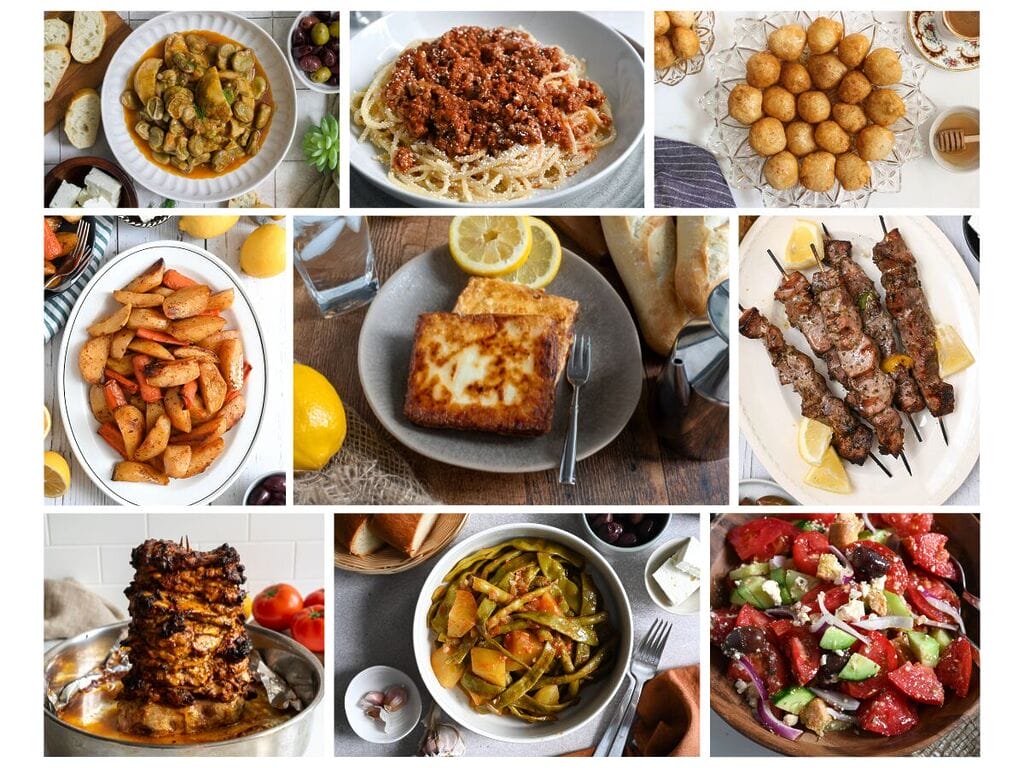
Growing up Greek, we had Greek food all the time. My parents only cooked meals and desserts that they were familiar with, that they grew up on, and that they loved. Bonus that Greek food is so delicious and nutritious. It is no wonder that every year travellers from all over the world visit Hellas and experience everything that this glorious country has to offer, including the food.
I have compiled some of the best Greek foods that I think you should try while you are visiting Greece. If you are back from your travels, or remember having been to the birthplace of civilization years before, you can now recreate the tastes and smells of Greece right in your own kitchen using the Mia Kouppa recipes!
Of course, this is only the tip of the iceberg and there is so much more Greek food and desserts to love and enjoy. Be sure to check out the rest of the Mia Kouppa website, where you will find over 600 recipes that you can either order in a taverna in Greece, or make yourself at home, no matter where you are in the world!
Spanakopita (Greek spinach pie)
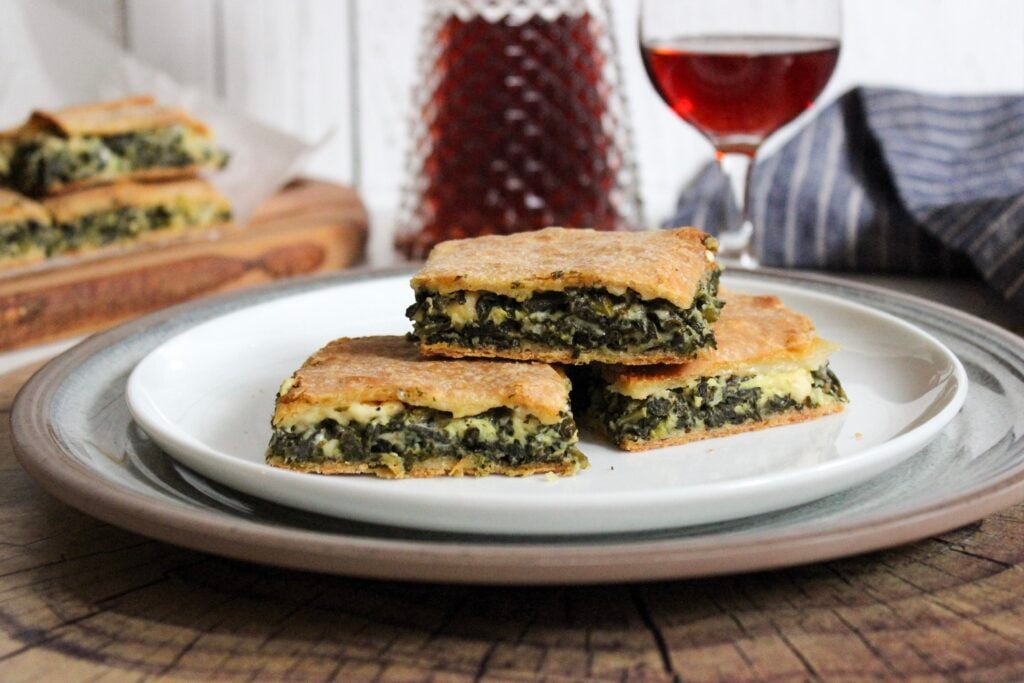
The iconic Greek dish! Ask anyone, Greek or non-Greek, to name one of their favourite Greek dishes and Spanakopita is definitely going to be in the top 5! There are so many variations of this spinach pie, and it is made differently across different regions of Greece, but also across families. In my family, my parents have taught us how to make several versions of spanakopita, including a vegan spanakopita, a spanakopita made with store-bought crispy phyllo, and this one pictured above.
This phyllo dough in this spanakopita (actually, it is called a spanakotyropita because it contains feta) is rich and made with simple ingredients – flour, olive oil, milk, eggs and a touch of red wine vinegar. The filling is loaded with spinach, onions, fresh herbs and of course, feta. Baked until the phyllo is crispy, spanakopita is one of my favourite ways to eat my greens!
In Greece, people often have spanakopita for breakfast. It can be picked up in most bakeries, and coffee shops. Of course, spanakopita is delicious any time, including as part of a meze table if you happen to go out for some drinks and bouzoukia!
Greek grilled octopus

A quintessential Greek photo is one where you see octopus hanging on a line by the sea, drying in the hot, Greek sun. Octopus is a delicacy in Greece, which does not imply that it is a rarity – just that it is prepared so perfectly! Visit any psarotaverna (seafood restaurant) and you will certainly see octopus, usually grilled, on the menu. Often, it will come served with a spread of fava, the yellow split pea dip most famous in Santorini.
Back home I like to prepare octopus in a way which is reminiscent of the amazing flavours in Greece. It is a process to be sure, but not one that is very difficult. Do not be intimidated to order octopus in a restaurant in Greece, or to make it yourself at home using my step by step instructions and fail-proof Greek grilled octopus recipe. The result is tender, flavourful and utterly delicious. I love to serve octopus prepared this way with a few lemon wedges on the side, a few other mezedes like Fried calamari, Marinated olives and plenty of Homemade Greek pita bread. And, octopus always tastes better in my opinion with a little bit of ouzo to wash it down with!
Bougatsa

Grab a bougatsa and head to the beach! This is probably one of my favourite ways to start the day when I am in Greece. This custard filled, phyllo wrapped pastry is so good! It is light, creamy, perfectly sweet and when made the way I make them, so easy to eat. No need to cut portions out of a larger pan; individual bougatsa parcels are the way to go!
There are actually different versions of bougatsa that you will find in Greece; some are savoury and filled with cheese. This bougatsa however pictured above is a sweet version. It is filled with a light cream and once baked the crispy phyllo is dusted with a bit of cinnamon and powdered sugar. I love making bougatsa at home – all I am missing is the beach!
Frappé, Greek cold coffee

Over on the Mia Kouppa Facebook page, a recent question was: You land in Greece! What is the first thing you do? About 50% of people who responded mentioned grabbing a Frappé, the iconic Greek cold coffee! No surprise! There is no better way to get your caffeine fix than with a cold coffee made just the way you like it!
The secret to a great Frappé is making sure that the water is really cold and that the foam which is created either by shaking or whizzing with a mixer is perfect – not too much, not too little. Confusing? Don’t worry, I have created a post which explains exactly How to make Frappé, Greek cold coffee no matter where you are in the world! Having said that, the best Frappé is the first one you have when you land in Greece – take a deep breathe, take a sip, and take a minute to appreciate everything Greece has to offer!
Moussaka
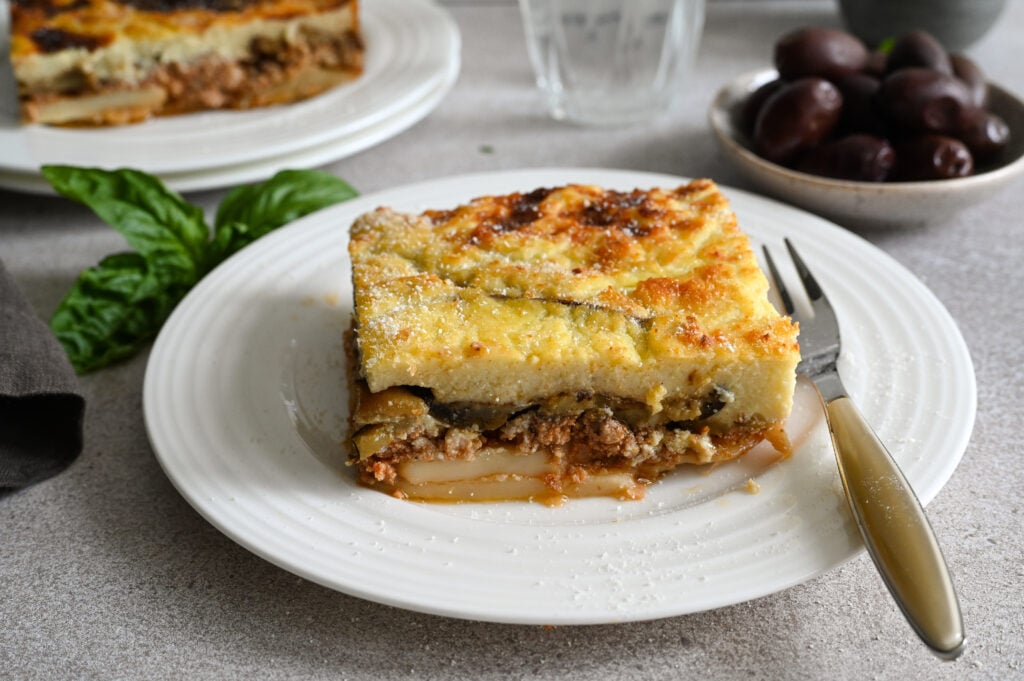
This classic Greek dish is a must have while in Greece! Moussaka is layers of delightful ingredients including eggplant, potatoes, ground meat all topped with a creamy bechamel sauce. It is fancy, but at the same time kind of rustic. Best of all, moussaka is a meal you can easily recreate at home, once your holiday is over and you are craving this Greek goodness!
There are many ways to make moussaka. Some people add a layer of zucchini, some add a lot of butter and cheese in the bechamel. When my family makes it at home, our moussaka is lighter than many. This does not mean that it is any less delicious – in fact I think that my parents’ recipe for moussaka is one of the best I have ever tasted – and I have tasted plenty! Some of the reasons it is so great include a really flavourful meat sauce, eggplant that it broiled and not fried, and a bechamel that is made with olive oil…yes, olive oil! It is incredible.
Tyropitakia or Cheese Pies
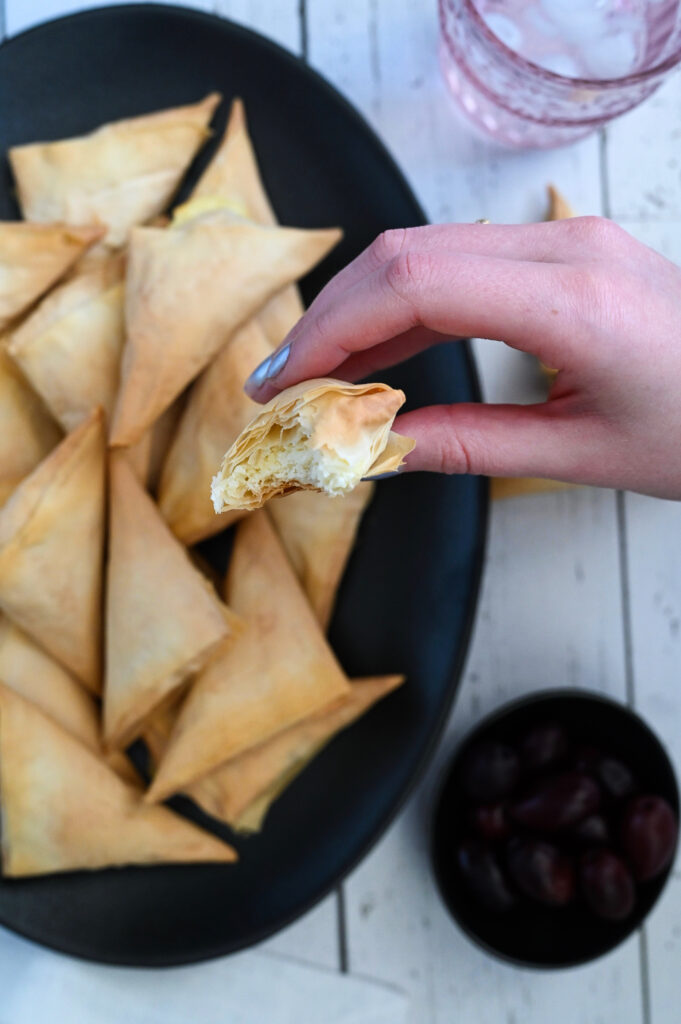
Tyropitakia or cheese pies are found all over Greece. They will vary from region to region and island to island, primarily because there are certain places in Greece that make very local and wonderful cheeses. These cheeses are then often used to make tyropitakia or tyropites. In the photo pictures, the tyropitakia are shaped into convenient two-bite triangles, formed by using store-bought crispy phyllo. Growing up, we never had a gathering at home without a platter piled high with these – they never lasted long!
In my family, tyropitakia are made with a filling of Greek feta and either ricotta or homemade soft mizithra (these are very similar). An egg and a bit of flour binds the filling and the result is a perfectly textured, wonderfully flavoured, addictive meze. Tyropitakia are easy to make at home, and if you do try them in Greece, once your holiday is over you will definitely find yourself craving them! Now, you can satisfy that craving!
Greek salad (or Horiatiki salata)
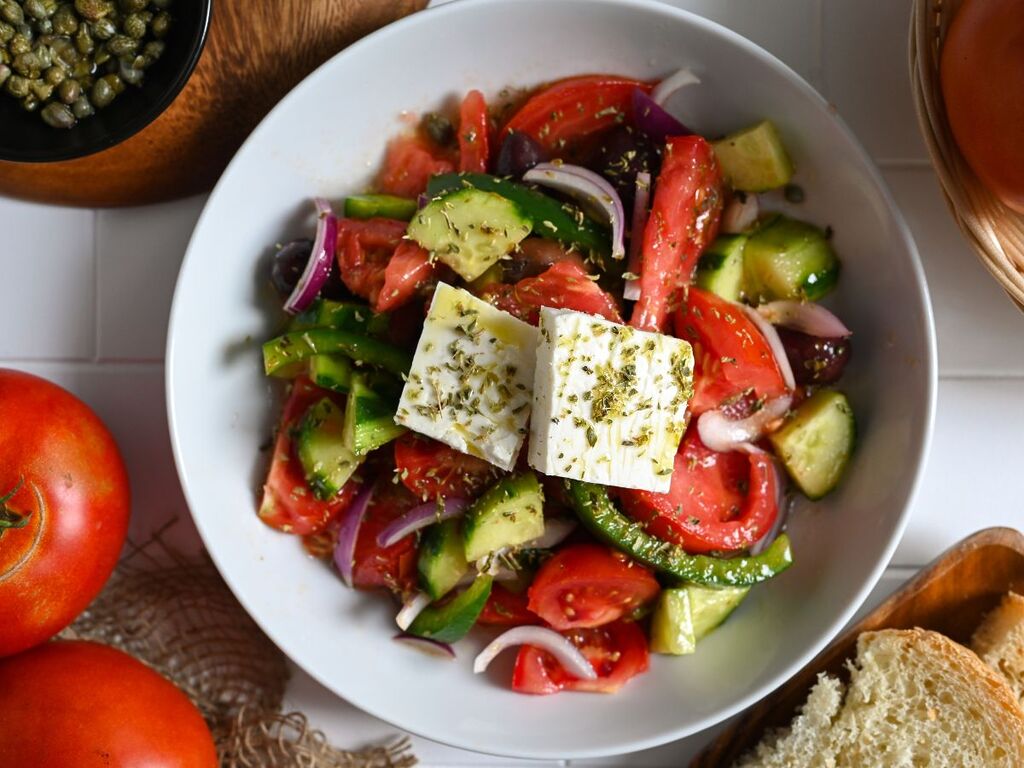
Anywhere you go in Greece, any restaurant, any taverna, any Greek home, you will find Horiatiki. Horio means village in Greece, and this simple rustic salad is a staple everywhere, and despite its name it is even found in big cities like Athens and Thessaloniki.
The key to an exceptional Greek salad is ripe tomatoes, crunchy cucumbers, plump Kalamata olives, slivers of red onion, pure Greek olive oil, fragrant Greek oregano and of course, Greek feta. There are variations to this, but in most places, these ingredients are the standard. When I am in Greece I have a horiatiki at least once a day. I usually enjoy it with a hunk of fresh bread, to help sop up all the glorious juice that gets left behind in the bowl.
Zucchini fritters – Kolokithokeftedes
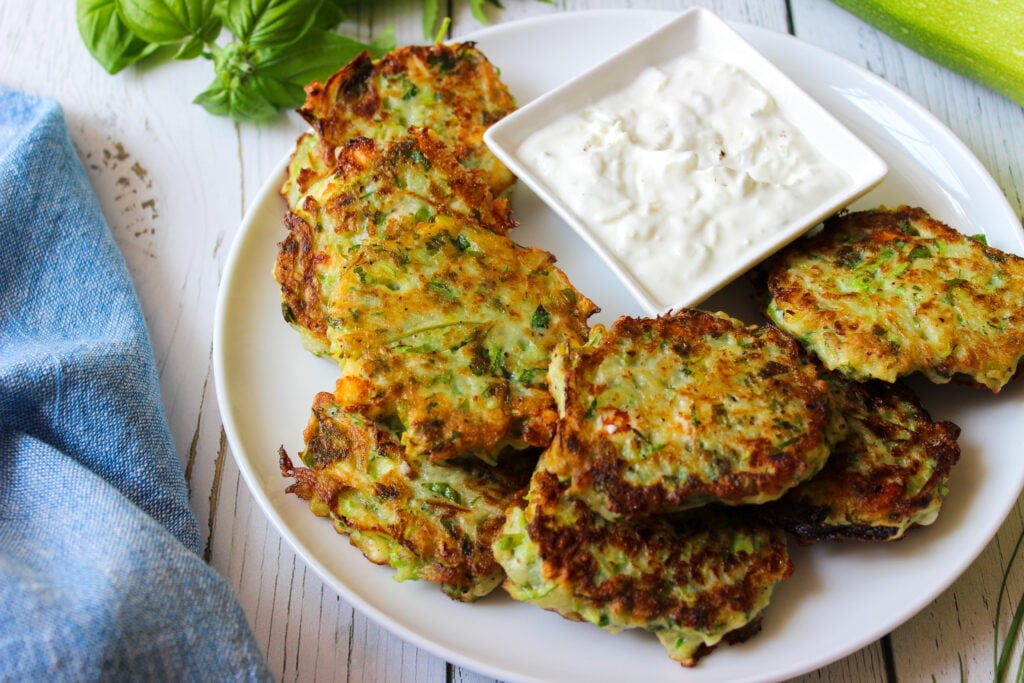
There is a whole array of dishes in Greek cooking called pseftokeftedes, which translates to fake meatballs. These are basically balls or fritters that are made with something other than meat. There are many pseftokeftedes out there, including ones made with chickpeas (revithokeftedes), tomatoes (domatokeftedes) and zucchini (kolokithokeftedes).
Zucchini fritters are great because they are light, crunchy on the outside, and soft on the inside. They are the perfect meze to enjoy while sipping on a bit of ouzo or raki, and they go great dipped into some homemade tzatziki. I like to make kolokithokeftedes at home too, especially when I have an abundance of zucchini from the garden. The are wonderful as a snack, as a vegetable side dish, and even as a salad topper.
French fries
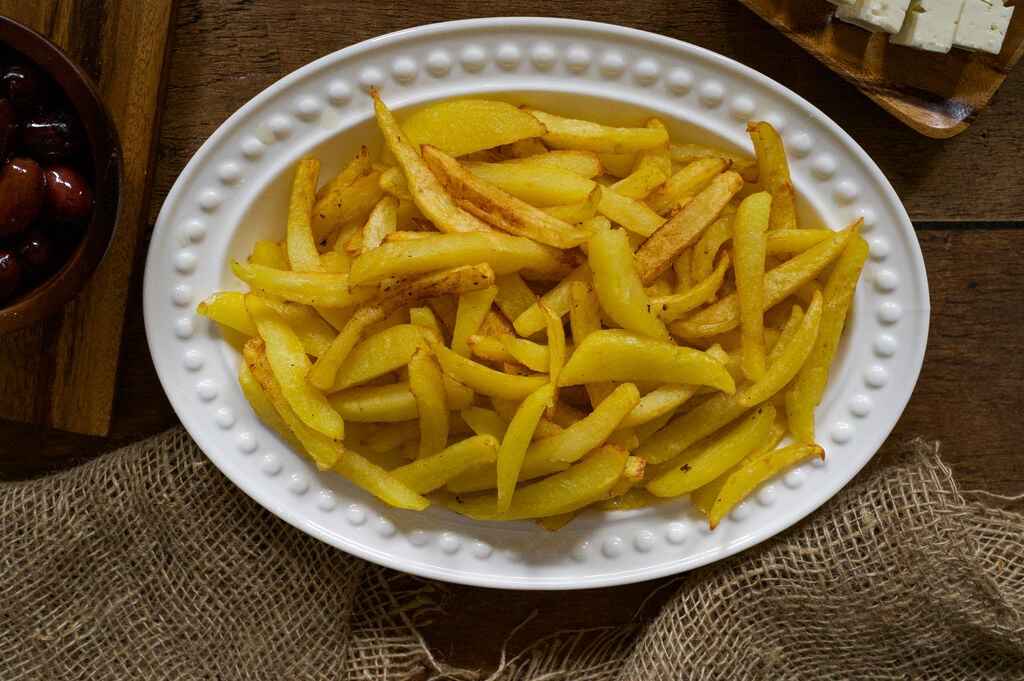
Okay, so I am sure that you have heard that olive oil has a low smoke point, and that it should not be used in frying. Well, someone forgot to tell the people of Greece, because they use olive oil to fry everything, including potatoes. Yes, it is true, and until you have tried potatoes fried in olive oil, you truly have not lived! They are out of this world!
The truth is that olive oil is a lot more stable than other oils when heated – and as a result does not break down into harmful components. It is of course much more expensive, but in my opinion, so worth it! Give them at try while you are in Greece, and then try it at home! Remember that you can reuse the oil at least a couple of times.
Ladenia Greek flatbread
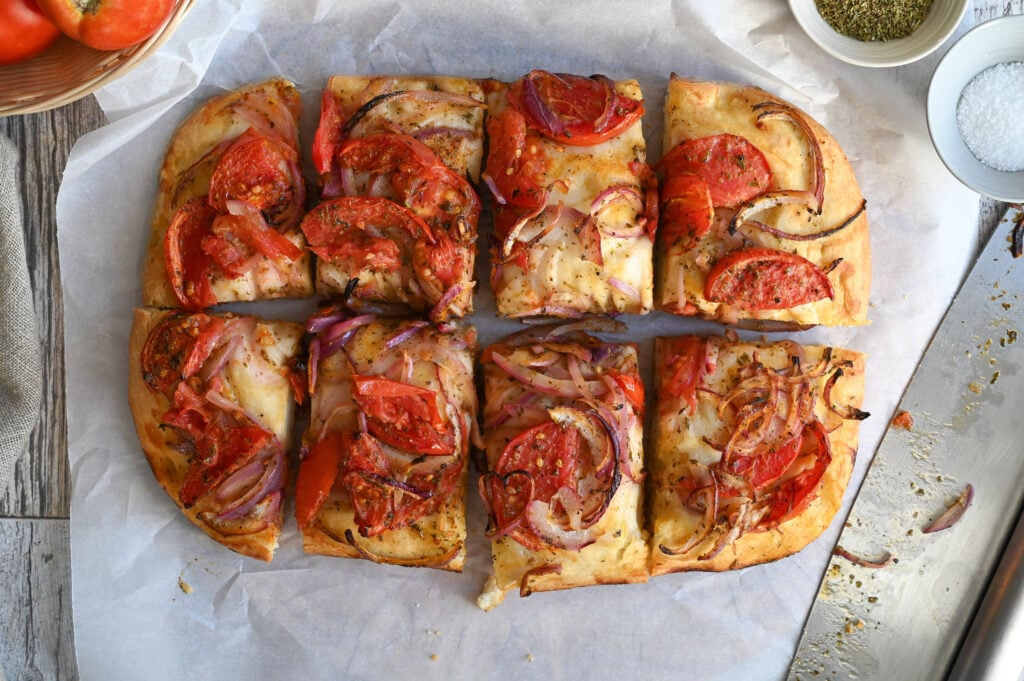
When I was in Milos one of the things I ate day after day was ladenia. This Greek flatbread topped with tomatoes is an island classic, but you can find variations of it across Greece. It is a delightful thing to have for a light lunch if you are opting for a meat-free meal. Served with a side salad, ladenia is a simple and delicious way to satisfy your hunger.
When I make ladenia at home I choose the ripest tomatoes I can find. I also add some red onion slivers, Greek oregano and olive oil. That is pretty much it! These beautiful ingredients on top of a perfectly pillowy dough are all you need! Want to know a tip? Ladenia can be purchased at many zaharoplastia (bakeries) and pieces can be wrapped up and tucked in your beach bag for when the hunger cravings hit after a swim. Ladenia travels really well!
Best traditional Greek dips and spreads
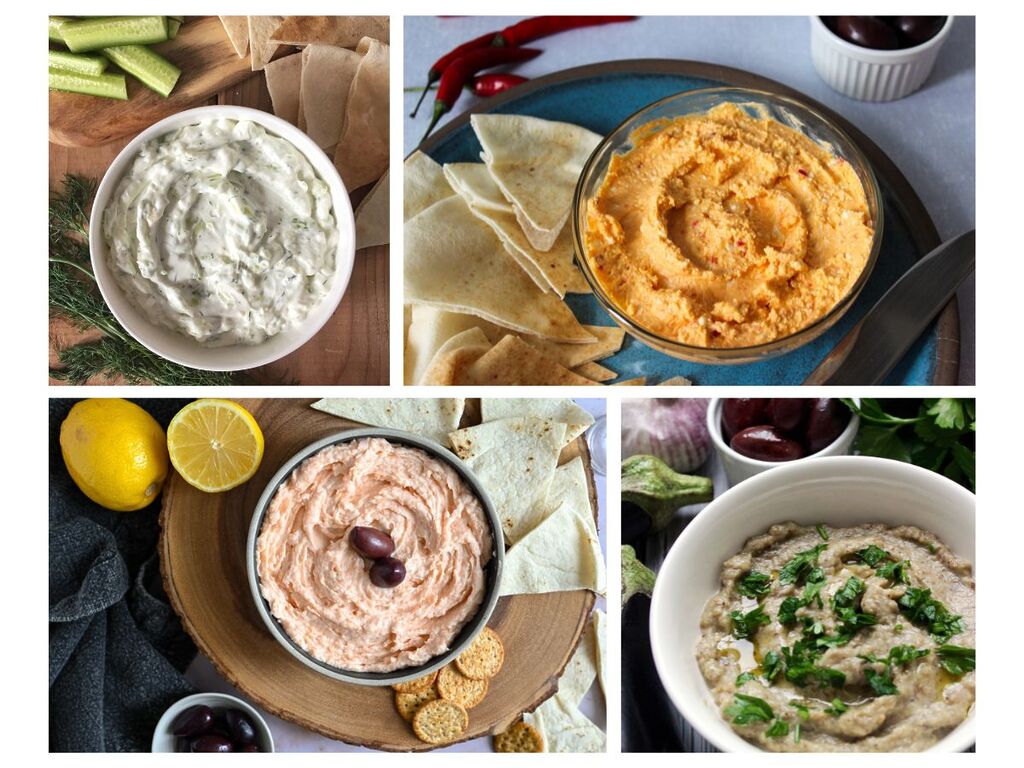
Okay, okay…I cheated a little here! This isn’t actually 1 of 30 recipes you must try in Greece…it is more like many recipes in one post. Who could blame me? How could I possibly recommend that you try one or two of these dips and spreads while you are in Greece? You need to try all of them!
Greeks love their dips, and spread! There really is something for everyone, from the classic yogourt and garlic based tzatziki, to the rustic and simple melitzanosalata (egpplant dip) to the spicy tyrokafteri made with feta and hot peppers. There is just so much to love! Sometimes all you need to order is some fresh Greek pita bread and an assortment of traditional Greek dips and spreads. Pour some raki or ouzo, blast the Greek music, and watch the joy and love spread!
Roasted lemon potatoes
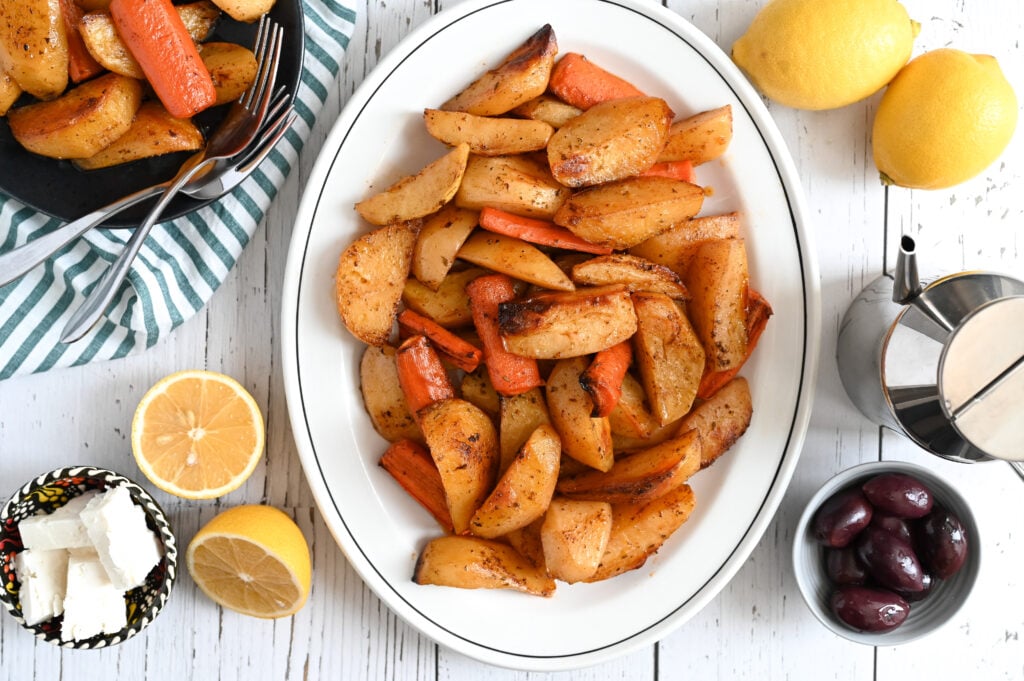
You know potatoes are great when they could be an entire meal. Its true! Sometimes, especially on days when I am not eating meat, I order Roasted lemon potatoes, a side of olives, maybe some feta and bread, and that is it! And guess what…it is enough! Greek potatoes are famous and for good reason! Made right they are full of flavour, perfectly textured, and they have crunchy bits and a creamy inside. Roasted lemon potatoes are definitely something you have to try in Greece!
There are many recipes out there that explain how to make the authentic Greek roasted lemon potatoes. All I know is that anyone who tries my family recipe is blown away by it. One person said that these potatoes were the best thing they had ever put in their mouths! That says a lot! Don’t be turned off by the amount of oil called for, or how long the potatoes roast for. Trust the process – it is all worth it!
Spaghetti with meat sauce (Greek Makaronia me kima)

If you think that ordering spaghetti with meat sauce is something that you should make sure to do only in Italy, think again! The way Greeks make makaronia me kima (spaghetti with meat sauce) is epic! The meat sauce is absolutely incredible, and spiced in the most incredible way. It is no wonder that the famous Cincinnati chili is basically makaronia me kima rebranded for an American audience.
A truly great plate of Spaghetti with meat sauce (Greek Makaronia me kima)j has a taste you will not soon forget. If you ever decide to make this meal yourself at home (and you should using my recipe!) you will also be surprised at the way the sauce is actually prepared. The ground meat basically stews in the tomato sauce. The result is a meat sauce that I can’t resist tasting spoonfuls off straight from the pot – for taste-testing purposes of course!
Greek Gigantes plaki

If you think a plate of beans is a boring dish to order when you are on holiday, think again! Gigantes plaki is a popular Greek meal for a reason! It is filling, delicious, vegan (so appropriate for lent) and really traditional. The key is to make this dish with actual gigantes (white runner beans), which are easy to find in Greece. These large, meaty beans cook up creamy on the inside but still retain their shape.
If you want to make gigantes plaki at home, sourcing the actual gigantes might be your biggest challenge. Having said that, many Greek or Mediterranean markets will carry them, and they are also available for purchase online. If you are still in Greece, or know someone who is, tell them to skip the keychain and bring you back a bag or two of gigantes instead. Another option is to make this dish with giant lima beans. It won’t be the same, but it will still be great.
Galaktoboureko, Greek custard dessert

I am a little spoiled. My Baba makes the best galaktoboureko I have every had, and I have had plenty! Fortunately for all of us, he did share his recipe and so now you can also make his galaktoboureko at home. Everyone absolutely loves this custard filled, phyllo-topped (and bottomed) dessert that is soaked in a sweet syrup.
Although I don’t think you will have a galaktoboureko that is better than my Baba’s (clearly, I am biased) it is absolutely worth ordering when you are in Greece. Enjoy it during the day with a Greek coffee or after dinner as your dessert. Many Greeks also like to start the day off sweet, so a piece of Galaktoboureko, for breakfast would also be perfectly acceptable!
Greek ham and cheese pie (Zambonopita)
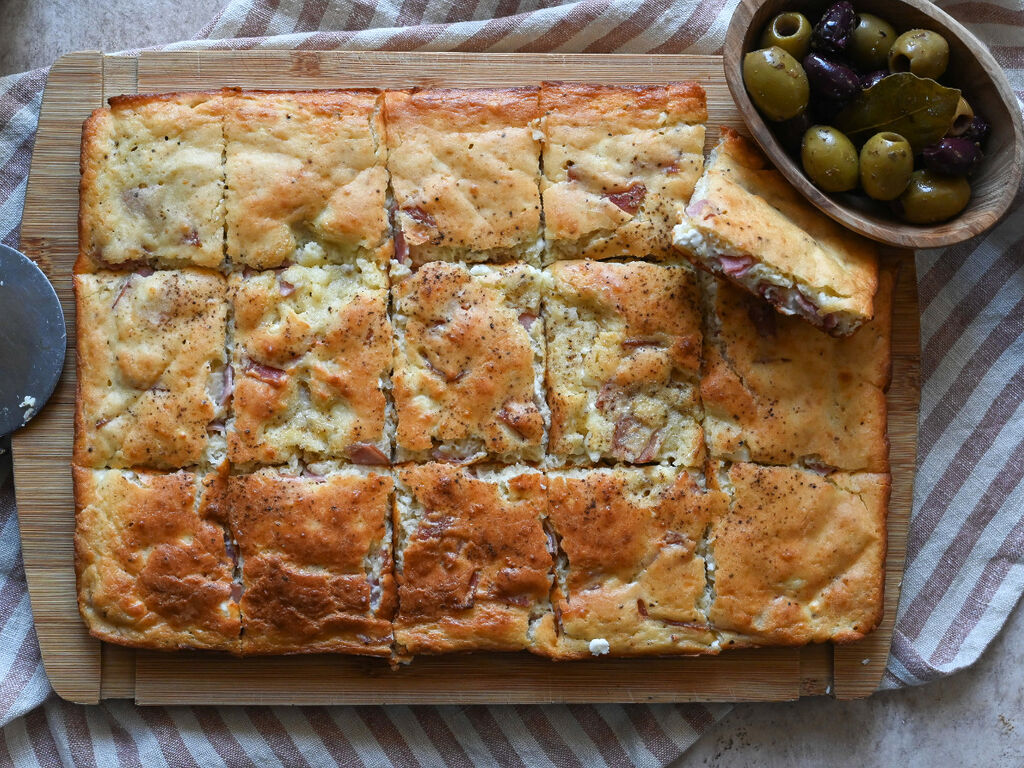
In Greece you will find many dishes that include pork. Although most people think that the meat of choice in Greece is lamb, pork is actually a more popular option in many parts of Greece. One of the most delicious ways it is used is in something called a zambonopita, a ham and cheese pita made without phyllo. This is a great thing to grab at a bakery on the way to the beach, and to munch on while strolling along the paralia.
Zambonopita can also easily be made at home, with ingredients you may already have in your kitchen. Basics, like eggs, flour, yogurt, milk, feta and of course, ham. The recipe is really versatile and I will walk you through some delicious ideas that you can use to really make an amazing Greek ham and cheese pie. This is a must try Greek dish that does not get the love and popularity it deserves outside of Greece. Let’s change that!
Pork souvlaki
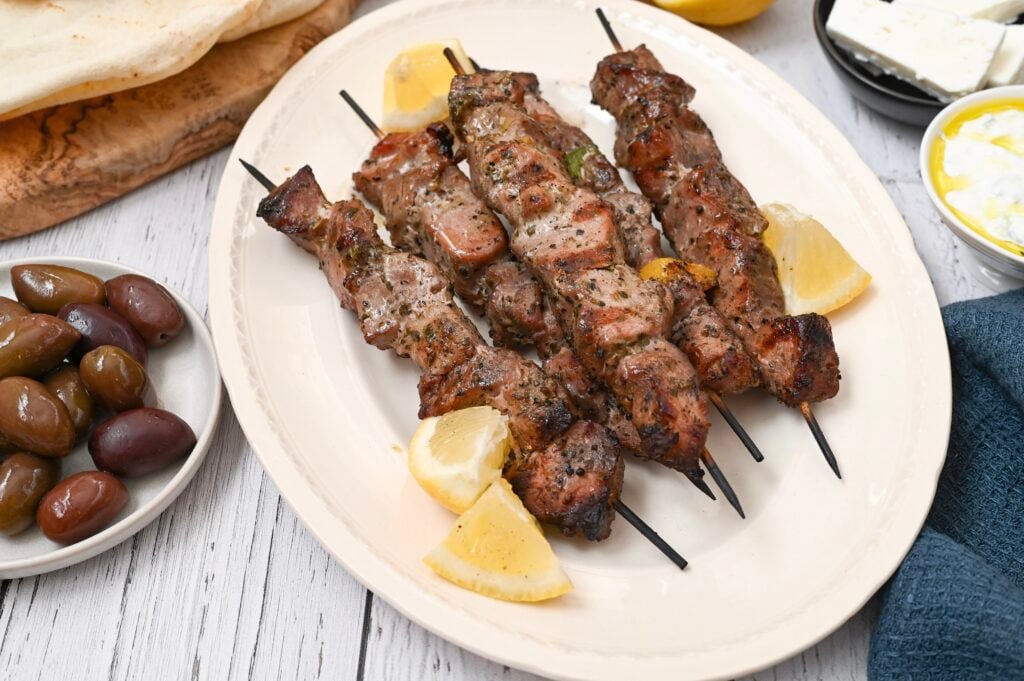
You absolutely cannot go to Greece and not enjoy a pork souvlaki. Like, this is not even an option, unless of course you don’t eat meat or pork. Pork souvlaki is found almost everywhere, and there are restaurants referred to as souvlagisika which make primarily souvlaki. So good!
There are many ways to enjoy souvlaki. You can have them straight off the skewer, with a squeeze of fresh lemon. They are so good this way! You can also make a souvlaki pita by removing the meat of the skewer and folding the cubes of pork into a pita bread with tomatoes, tzatziki, red onion and some French fries! The classic Greek way to enjoy a souvlaki pita!
Shrimp saganaki (Greek shrimp with tomato and feta)
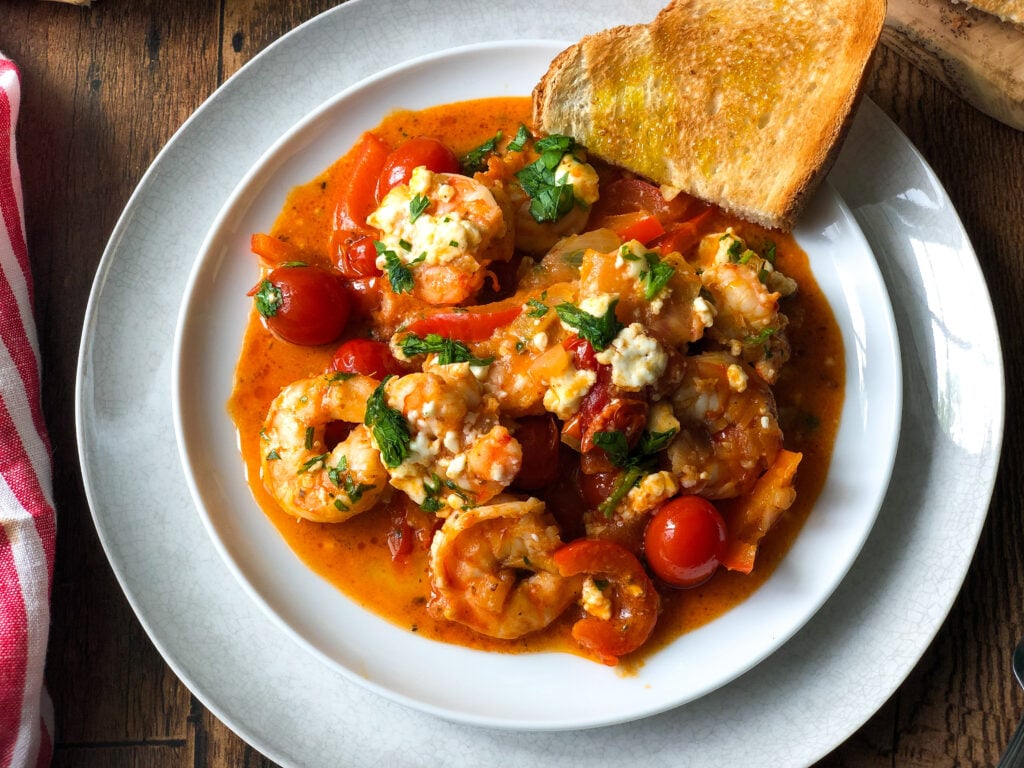
Shrimp saganaki (Greek shrimp with tomato and feta) is one of those dishes that you will marvel at! Honestly! The combination of flavours in this seafood favourite meze is out of this world. A great shrimp saganaki will feature the shrimp, of course, but the tomato based sauce will be equally delicious! Be sure to grab a hunk of bread – there is nothing like dipping into this amazing, rich sauce.
I love cooking with shrimp at home! I can usually find great quality frozen shrimp at my local grocery store. I love cooking with shrimp because even if it is a last minute decision, they thaw out pretty quickly under cold running water, and they cook up even quicker. Making Shrimp saganaki is a recipe I often turn too, and trust me when I tell you that it makes my family very, very happy!
Greek green beans with potatoes
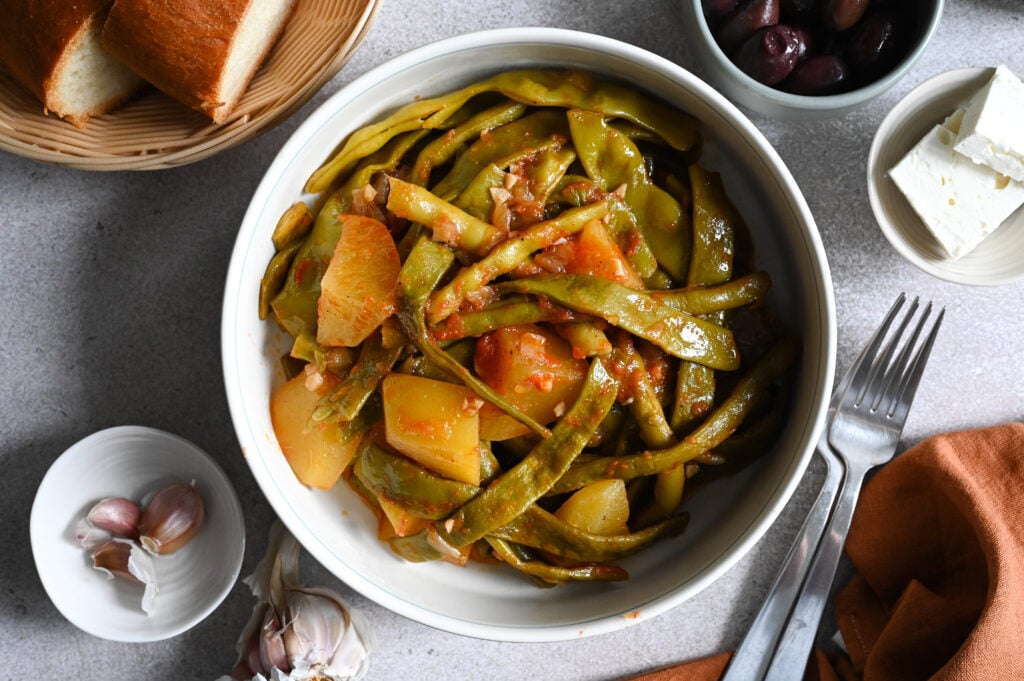
If you have never had green beans prepared the Greek way, get ready for an experience! Unlike many other recipes for green beans, where the advice is to cook until just tender and to plunge the beans into cold water to retain their vibrant green colour, Greeks do things differently. In this traditional recipe for green beans with potatoes (or fasolakia me patates lathera), the greens beans are cooked for a very long time. They are no longer firm, nor vibrantly green. They are however absolutely luxurious! This is a meal that yo do not want to pass up!
Naturally vegan, fasolakia me patates lathera is served as a main course. If you are eating cheese, then add some feta either crumbled on top or on the side. Don’t forget the bread! This dish creates a sauce that is perfect for dipping into! When I make green beans and potatoes at home, and I do often, I sometimes use frozen green beans if I can’t find good quality fresh ones. It works out just fine, so I can enjoy this meal with my family year round.
Dolmades (Stuffed vine leaves)
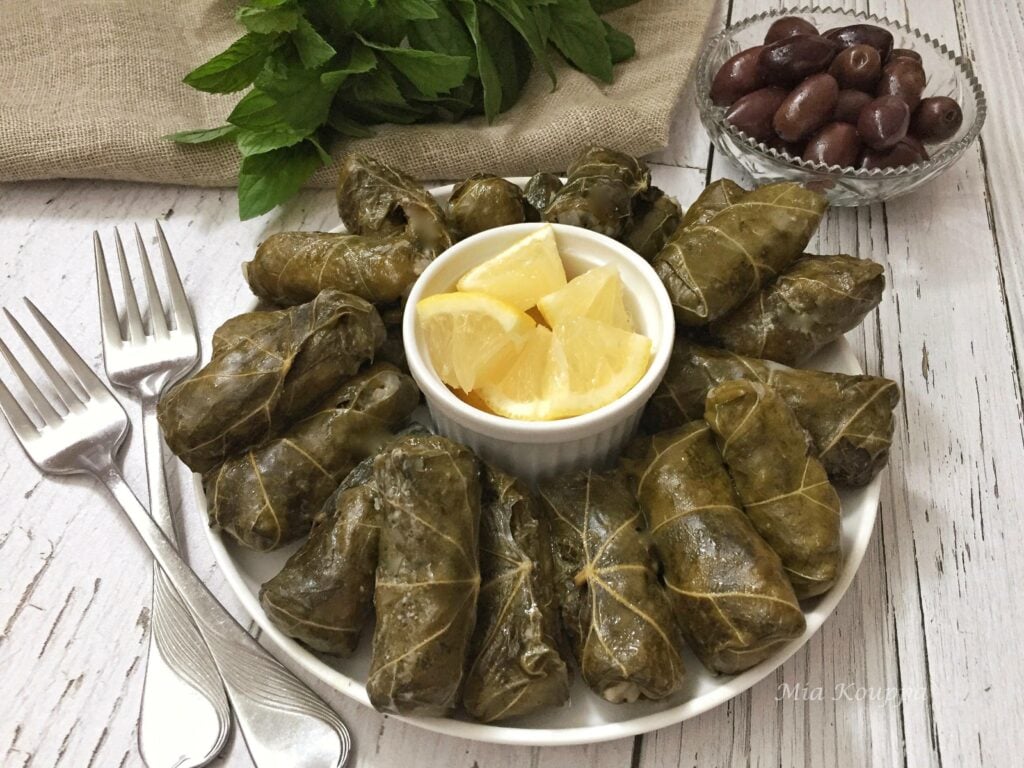
A Greek classic! Dolmades are small, two bite (or one bite depending on your bite!) mezes that are a favourite amongst Greeks and travellers to Greece! Vine leaves are used to wrap up a filling that typically includes rice, herbs, and occasionally meat. My preferred way to eat, and make, dolmades is without meat and I serve them with fresh lemon to drizzle over top. This is definitely a must try dish that is available in almost all regions of Greece, with some slight variations.
Making dolmades at home is really easy if you can find the vine or grape leaves. I explain to you how to source them, how to prepare them, and in a pinch, how to purchase them. Although rolling the dolmades takes a bit of practice, I take you through these steps too!
Greek artichokes with fava beans (Aginares me koukia)
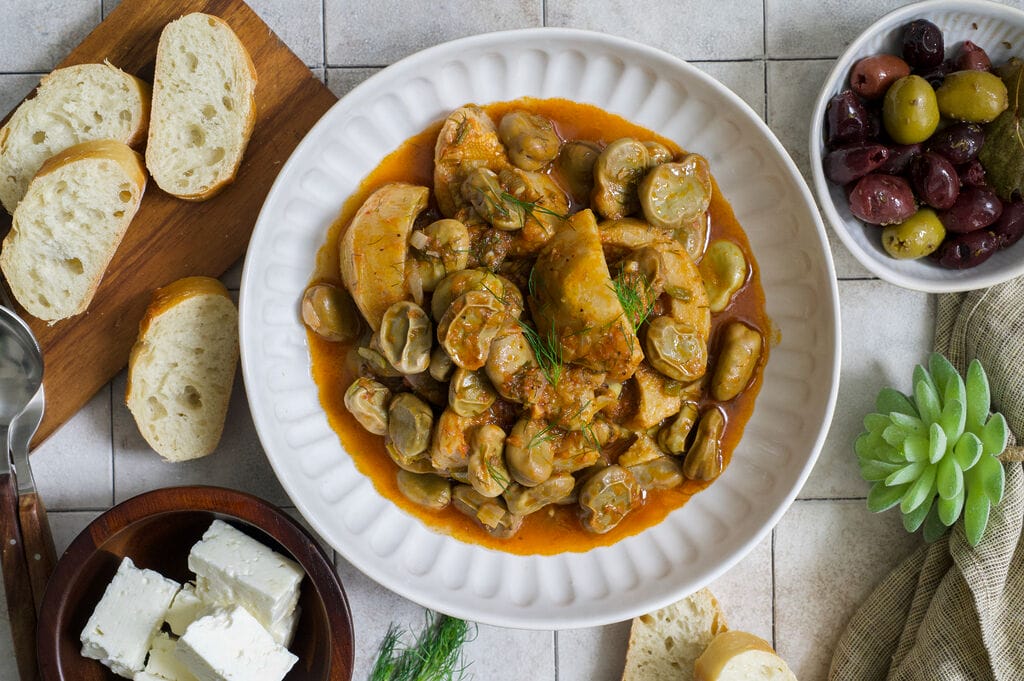
I remember years ago a colleague returning from a trip to Greece and telling me that her husband was still raving about a dish they had in Crete. She could not remember the name, but after some questioning it was clear, the meal they had was aginares me koukia or artichokes with fava beans! I know what you are thinking…really? Artichokes and beans? To that I say, yes!! Trust me, and my colleague’s husband!
Aginares me koukia is another one of those rustic Greek meals that you are lucky to find on a menu. You may not find it offered at the tourist traps but establishments that cater to locals, especially in Crete where this dish is really popular, will likely have it. This plant-based meal is the perfect representation of authentic and traditional Greek cooking – real foods, simple ingredients, easy cooking technique, and just perfection!
Fried fish

If you are going to have small fried fish anywhere for the first time, let it be in Greece! This is a real Greek treat in my opinion and small fried fish are available in most all psarotavernas (fish and seafood restaurants). This is a humble, rustic dish and it always has me envision a table set with a blue checkered tablecloth surrounded by mismatched and wobbly chairs, with good-natured people sitting around enjoying carefree conversation, this amazing meze, and a constant flow of ouzo or raki. Beer too goes great with these small fried fish!
Outside of Greece you can still make this wonderful meze. The type of fish you will use will vary depending on where you are in the world. The key is to ensure that the fish is fresh (it is okay if you buy it frozen – sometimes that is the way to get the freshest fish!). You also want to make sure that the fish is edible, head to tail, the way most small fish are!
Greek Cheese Saganaki
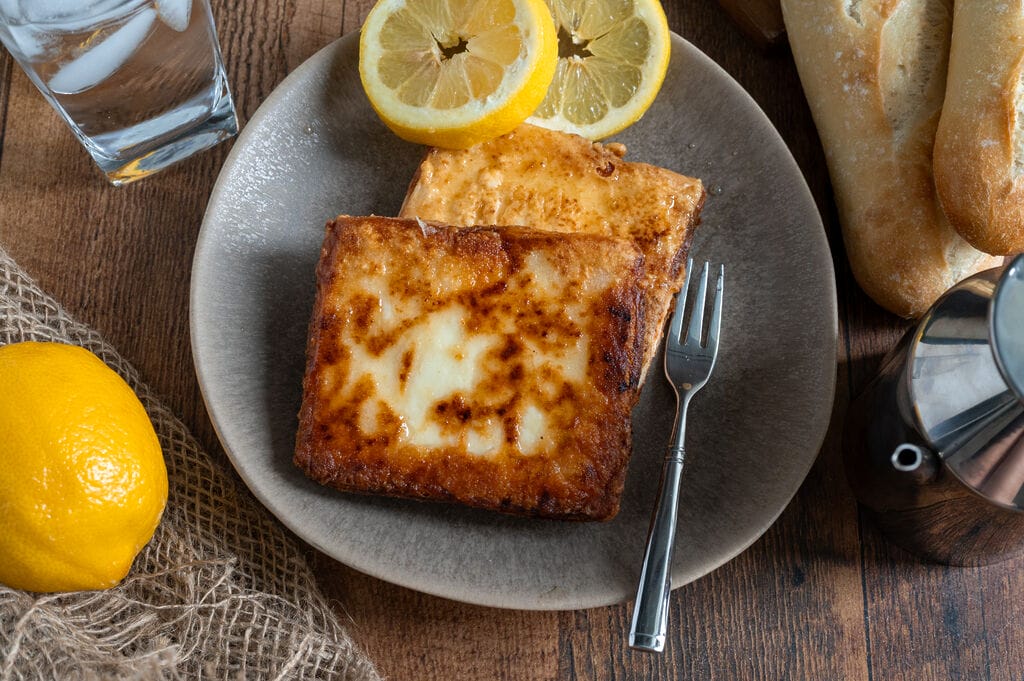
Can you say Opa! That is definitely what you will want to cheer once you taste a great cheese saganaki! Think about it! Great Greek cheese, coated in flour, fried and then possibly flambeed with some ouzo or cognac, and served with fresh lemon juice. Honestly, it does not get better than this!
There are many Greek cheeses which can be used to make cheese saganaki, including kefalotyri, kefalograviera, kasseri and halloumi. Some people also say that you can use feta, but honestly I have never had a feta saganki. When I make this meze at home I usually use kefalotyri or kefalograviera. Everyone absolutely loves this Greek appetizer, and I love how quick and easy it is to make.
Greek Chicken Gyros
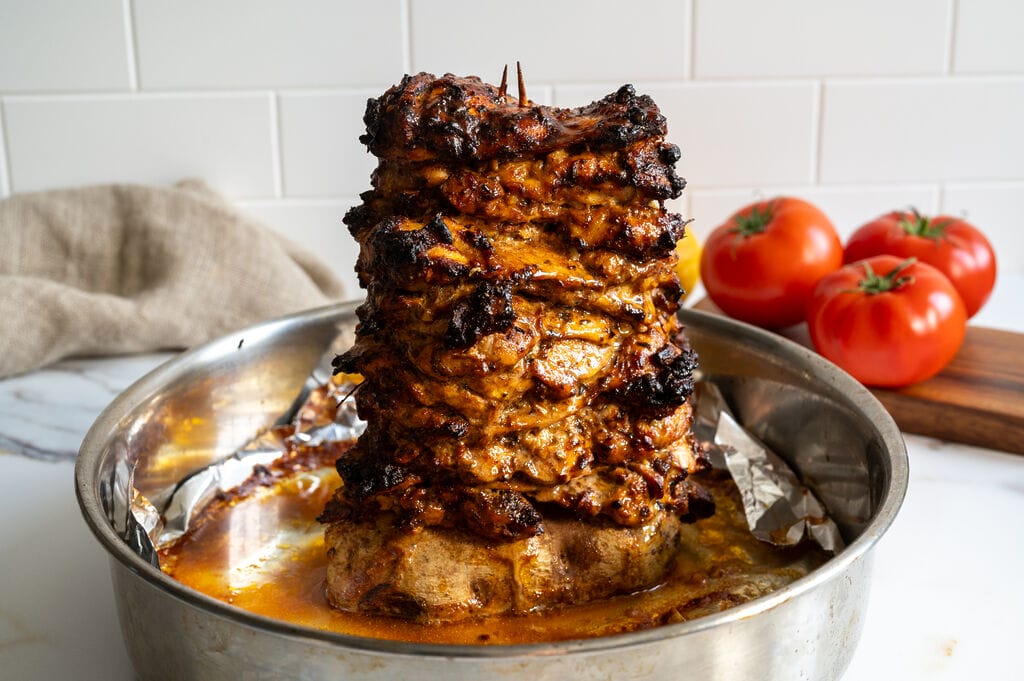
There is an age-old debate that exists amongst Greeks (actually there are quite a few, but this is one of them). What reigns supreme? Souvlaki, or gyro? Guys, I would never say that gyro is better than souvlaki, or that souvlaki is better than gyro, because I think it all depends on the mood, the location, and the craving. Having said that, a great gyro is, frankly, great!
Gyro is typically made with either pork or chicken but lamb can also be used. It is meat which has been arranged on an upright skewer that rotates slowly (hence the name gyro which means turn. or to round) while it cooks. When it is time to serve a portion the meat is carved off into strips. It is definitely something to experience while you are in Greece. Gyro can be enjoyed either as part of a platter, with French fries and a salad usually, or in a pita, toasted with the meat, tzatziki, tomatoes and red onions. In true Greek fashion, you will also see a few French fries added inside the gyro wrap as well.
Although it might seem difficult to do, you can make chicken gyro at home. I explain how to prepare and arrange the meat, how to roast it, and then how to serve it. Making chicken gyro at home is easy, impressive and makes for a fun and delicious meal!
Loukoumades

Oh loukoumades! Is there anything better than balls of perfectly fried dough topped with honey and sprinkled with chopped nuts and a bit of cinnamon? That is how I like to serve my loukoumades, and this is how they are often served in Greece. Loukoumades are such a loved Greek dessert that I have been to restaurants and tavernas where this is the only dessert on the menu. I have also been to places where, after a meal, the waiter brings a platter of loukoumades and a bit of raki or ouzo to the table, on the house. A sweet Thank you for dining with us! Greeks really do know how to live!
Making loukoumades at home can also be a lot of fun. In my recipe I explain not only how to make the perfect dough, but also how to safely fry the loukoumades so that they cook perfectly, and without any mishaps! These loukoumades are soft, pillowy and not even a little bit greasy! Give them a try at home and taste a bit of sweet Greece in your own kitchen!
Cretan dakos
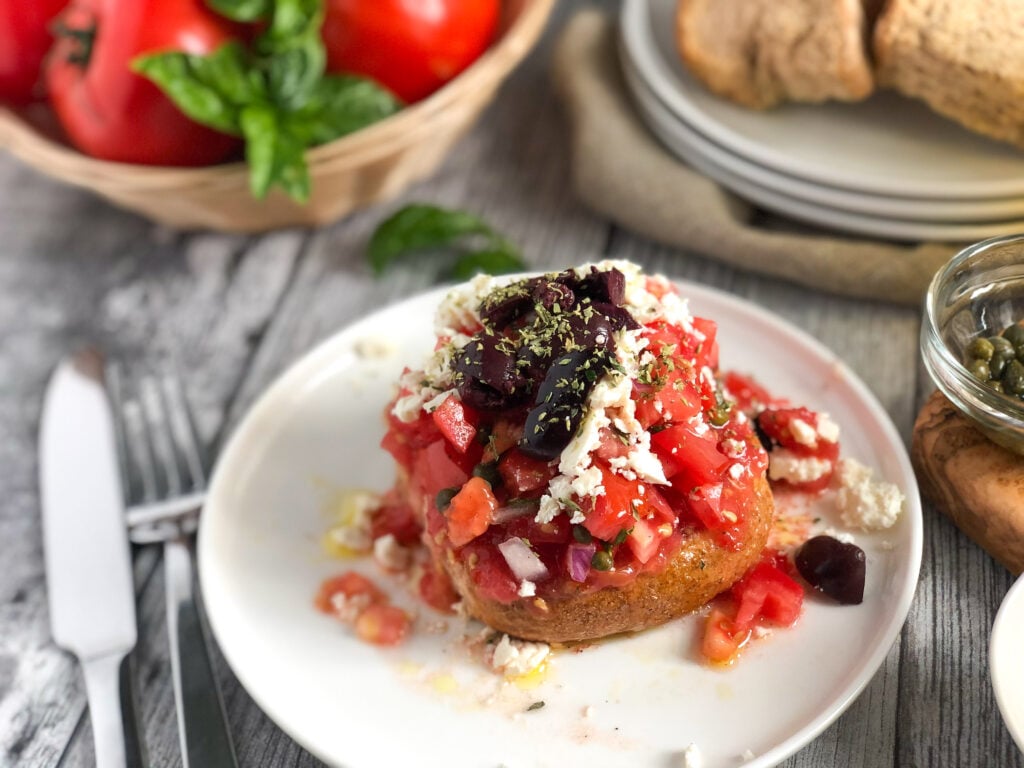
Talk about Greek goodness! Cretan dakos is part salad, part bruschetta, and total happiness. This popular dish, especially popular in the gorgeous island of Crete is made by topping a barley rusk with chopped tomato, olive oil, feta, olives and herbs. The softened barley rusk soaks up the juices of the topping and the result in a wonderful combination of flavours and textures, in every bite.
I like to make Cretan dakos at home for breakfast when I have the time. Paired with a Greek coffee or a frappe, it is the perfect way to start the day. When my mornings are too rushed, Cretan dakos makes the perfect light lunch or even no-bake dinner. Wonderful when the tomatoes are ripe, and it is too hot out to cook!
Fried phyllo wrapped feta

There are so many ways to enjoy feta! This quintessential Greek cheese is something that you will definitely try in Greece. It is available everywhere, and is served in so many amazing ways. Unless you are keeping a dairy-free diet, be sure to try as much feta as you can – it will vary slightly from region to region but it will all be delicious! In Greece you can be confident that you will be eating true feta, made with sheep milk, or a combination of sheep and goat milk.
Although feta in all forms is amazing, be sure to try feta wrapped in phyllo dough which is then fried. You are going to end up with a soft, warm and creamy feta center and a crispy phyllo exterior. This is a wonderful meze and I like to make it at home too. When I make Fried phyllo wrapped feta I also use a few dried chili flakes, and I drizzle it with chopped pistachios and honey. So good, and so easy!
If you want to learn more about feta, check out my post on Feta facts: Everything you need to know about Greek feta cheese and how to use it
Portokalopita (Greek orange cake with syrup)
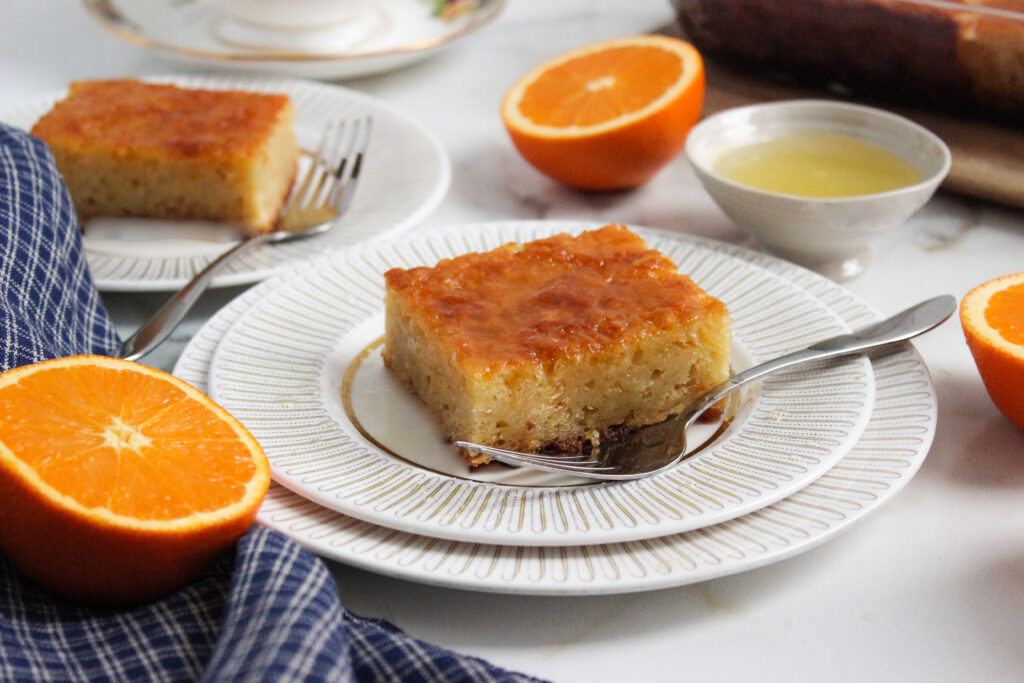
Walk into any zaharoplastio (bakery) in Greece and you will certainly find a tray or two of portokalopita! Unless of course you go in too late in the day and it is all gone. This lovely Greek orange cake is made in a really unique way, using dried up and crumbled phyllo instead of flour. The cake is full of orange flavour and after it is baked it is soaked in a sweet orange flavoured syrup.
Although portokalopita is really quite delicious, many non-Greeks are less familiar with it than other dessert like galaktoboureko or baklava. I want to change that! One way to do that is with this recipe! I have to say that I am so proud when people who have tried this recipe write to us and say that this is the best portokalopita recipe they have ever tried, and that it rivals any portokalopita they have had in Greece. High praise! Thank you!
Yemista or Gemista
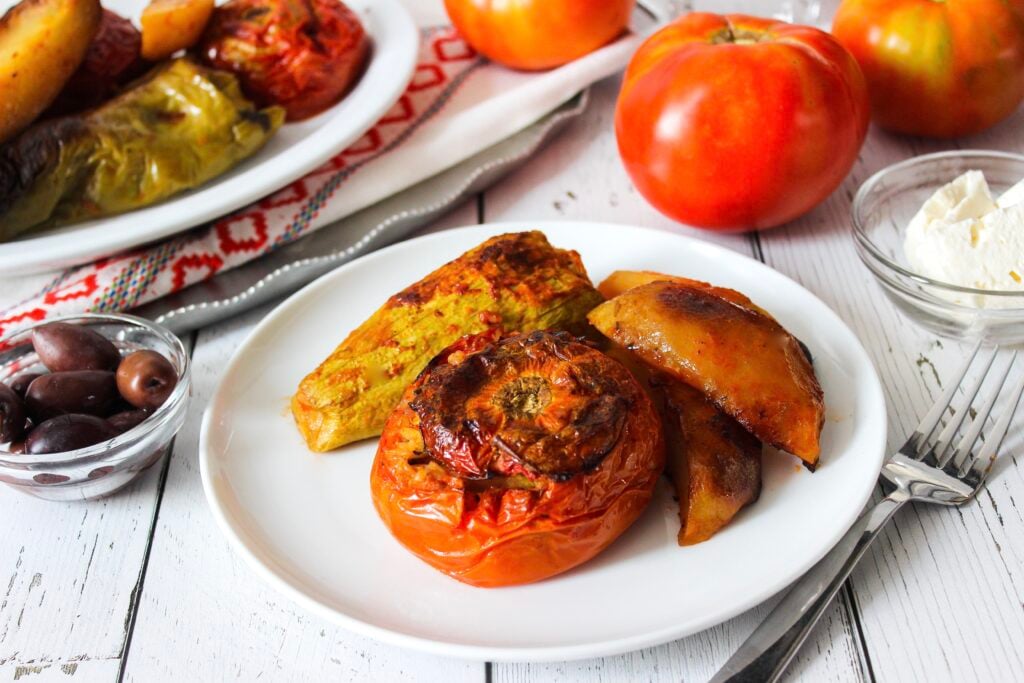
This is probably one of my favourite summer meals! Yemista, or Greek stuffed vegetables are a wonderful way to highlight the simplicity and rustic nature of Greek cooking. I remember being in Greece during the summer and my aunt dropping off a huge pan of prepared yemista at the local fourno (bakery) on our way to the beach. While we were swimming and enjoying the sun, our yemista would be cooking. On our way home we would pick them up and lunch was ready! This was a great way to save time, and avoid overheating the home.
I love yemista made orphana – this is the term used to described stuffed vegetables that do not contain any meat. Just like my parents taught me to make them, my preferred yemista are filled with rice, vegetables and plenty of herbs. One of the great things about yemista is that often the pan is full of a variety of stuffed vegetables, from tomatoes to zucchini to bell peppers to eggplant. Each one tastes a little bit different, so there is something for everyone!
Horta, Dandelion greens
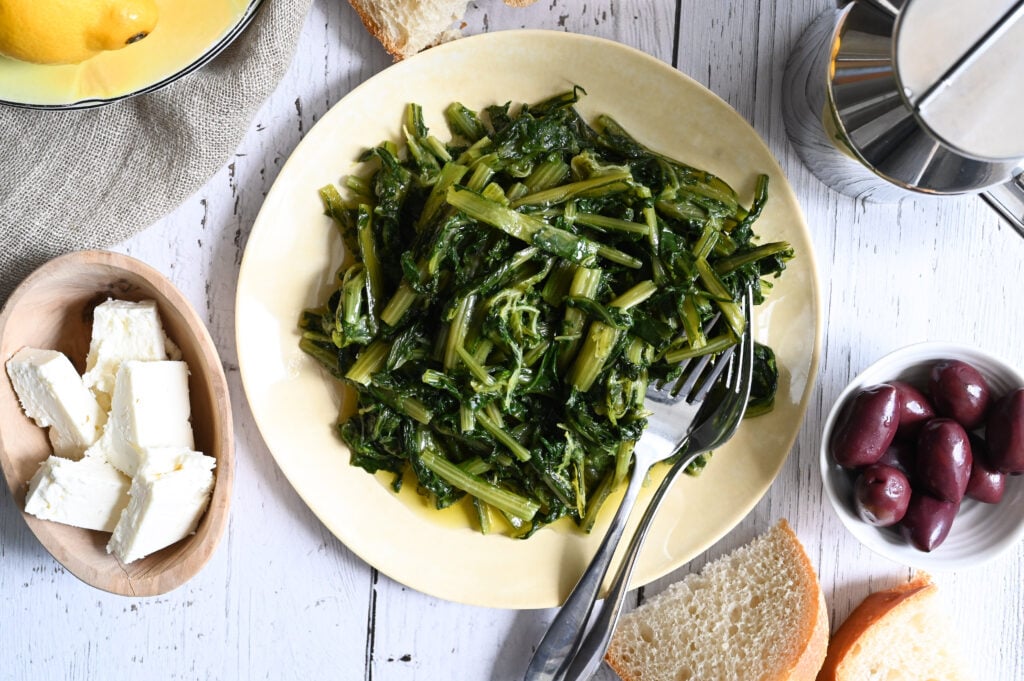
In Greek cooking, greens are really celebrated. So much so that they are often the meal itself. Ordering a plate of horta could be a side dish, part of a meze selection, or the meal itself if you add some bread, olives and feta on the side. When you order horta in Greece, the exact greens you get might differ from place to place, depending on what is growing locally, and what is in season. Don’t worry though, all of it is wonderfull and usually served simply with a generous pour of olive oil and some fresh lemon juice (or vinegar).
For me, and I know for many other Greek children of immigrants, horta hold a special place in our hearts. We have fond memories of going to pick wild growing greens with our families – a sort of immigrant field trip, literally in the field.
I really hope you have enjoyed this collection of recipes that I think you should definitely try in Greece, or try making at home so that you can bring a bit of Hellas right to your kitchen! I would love to hear back if you do try any of these recipes, or if you think that I have missed something on the list!
